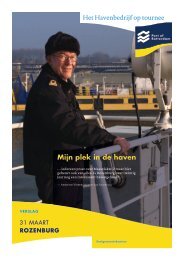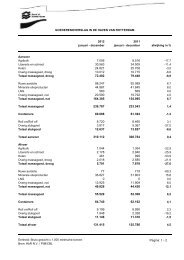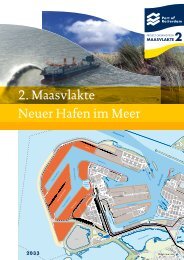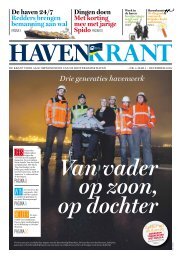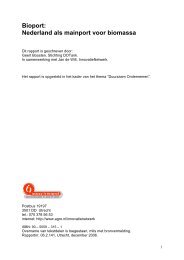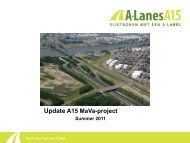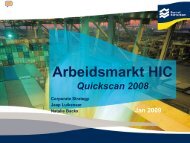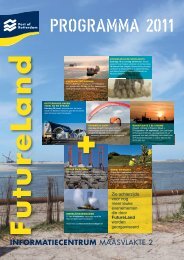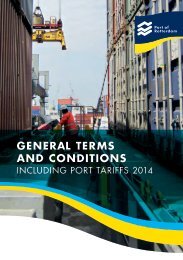2010 Port Waste Reception and Handling Plan - Port of Rotterdam
2010 Port Waste Reception and Handling Plan - Port of Rotterdam
2010 Port Waste Reception and Handling Plan - Port of Rotterdam
You also want an ePaper? Increase the reach of your titles
YUMPU automatically turns print PDFs into web optimized ePapers that Google loves.
INTRODUCTIONAs European Mainport <strong>Rotterdam</strong> is visited by more than 35,000 seagoing vessels each year. Shipson continental <strong>and</strong> intercontinental voyages produce ship waste en route. In addition, cargo residuesare left behind after the unloading <strong>of</strong> specific product flows. In order to prevent pollution <strong>of</strong> the sea <strong>and</strong>coastal waters the seaports in the Rijnmond Area facilitate <strong>Port</strong> <strong>Reception</strong> Facilities (PRF) where shipwaste can be delivered. It is after all <strong>of</strong> great importance that ship waste <strong>and</strong> cargo residues can bedelivered at a port <strong>of</strong> call efficiently <strong>and</strong> in an environmentally responsible manner.On 29 December 2002 the European Directive no. 2000/59/EC on port reception facilities for shipwaste <strong>and</strong> cargo residues (OJ L 332) came into effect. The purpose <strong>of</strong> this directive is the furtherreduction <strong>of</strong> discharges <strong>of</strong> ship waste <strong>and</strong> cargo residues into the sea. This directive thereforeconstitutes a further tightening <strong>of</strong> the MARPOL Convention.The provisions <strong>of</strong> the aforementioned directive were implemented in the Netherl<strong>and</strong>s by amendment<strong>of</strong> the Wet voorkoming verontreiniging door schepen (Wvvs – Prevention <strong>of</strong> Pollution from Ships Act).Pursuant to the provisions <strong>of</strong> Article 6, paragraph 1 <strong>of</strong> the Wvvs the manager <strong>of</strong> a seaport designatedby governmental decree must ensure an adequate facility suitable for the reception <strong>of</strong> ship waste.The port <strong>of</strong> <strong>Rotterdam</strong> is such a designated seaport 1 . The <strong>Port</strong> <strong>of</strong> <strong>Rotterdam</strong> Authority was appointedmanager <strong>of</strong> the <strong>Rotterdam</strong> port 2 . Pursuant to the provisions <strong>of</strong> Article 6, paragraph 3 <strong>of</strong> the Wvvs theport manager must draw up a suitable plan for the reception <strong>and</strong> processing <strong>of</strong> ship waste.On account <strong>of</strong> the foregoing the <strong>Port</strong> <strong>of</strong> <strong>Rotterdam</strong> Authority must therefore prepare the <strong>Port</strong> <strong>Waste</strong><strong>Reception</strong> <strong>and</strong> H<strong>and</strong>ling <strong>Plan</strong> (PWP)for the port <strong>of</strong> <strong>Rotterdam</strong>. The <strong>Port</strong> <strong>of</strong> <strong>Rotterdam</strong> Authority agreedin conjunction with the managers <strong>of</strong> the ports <strong>of</strong> Dordrecht, Maassluis, Moerdijk, Schiedam <strong>and</strong>Vlaardingen to adopt one joint PWP within the meaning <strong>of</strong> Article 6, paragraph 4 <strong>of</strong> the Wvvs for thewhole <strong>of</strong> the <strong>Rotterdam</strong>-Rijnmond <strong>Port</strong> Region. The <strong>Port</strong> <strong>of</strong> <strong>Rotterdam</strong> Authority was requested to takethe initiative in this. This <strong>2010</strong> PWP is the result <strong>of</strong> this <strong>and</strong> therefore applies to the entire <strong>Rotterdam</strong>-Rijnmond <strong>Port</strong> Region. The PWP was drafted following consultations with the relevant parties,including users, shipping agents, shipping companies, recipients, processors, permit issuers <strong>and</strong>enforcers in the <strong>Rotterdam</strong>-Rijnmond <strong>Port</strong> Region.Pursuant to the provisions <strong>of</strong> Article 6a <strong>of</strong> the Wvvs port managers must levy a fee towards the costs<strong>of</strong> reception, storage <strong>and</strong> processing <strong>of</strong> ship waste on operators <strong>of</strong> ships which call in at their ports.This is also referred to as indirect financing. Section 3 <strong>of</strong> this PWP sets forth the levels <strong>of</strong> the fees <strong>and</strong>reimbursements for the entire <strong>Rotterdam</strong>-Rijnmond <strong>Port</strong> Region. The guiding principle in this was theachievement <strong>of</strong> a balance between the costs <strong>and</strong> benefits <strong>of</strong> a cleaner environment.With this PWP, the previous PWP will cease to apply. The <strong>2010</strong> <strong>Port</strong> <strong>Waste</strong> <strong>Reception</strong> <strong>and</strong> H<strong>and</strong>ling<strong>Plan</strong> will come into effect on 1 October 2009.1 Cf. Article 2 <strong>of</strong> the <strong>Port</strong> <strong>Reception</strong> Facilities Decree in conjunction with Article 10 <strong>of</strong> the <strong>Port</strong> <strong>Reception</strong> Facilities Regulations2TK (Lower House), 2003-2004, 29 400, no. 3, p. 28.Version 3 October 2009 page 3 <strong>of</strong> 36 <strong>2010</strong> <strong>Port</strong> <strong>Waste</strong> <strong>Reception</strong> <strong>and</strong> H<strong>and</strong>ling <strong>Plan</strong>



